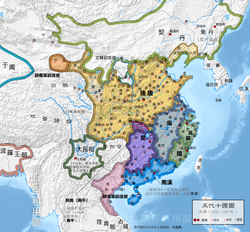Top Qs
Timeline
Chat
Perspective
Later Tang
Chinese imperial dynasty from 923 to 937 From Wikipedia, the free encyclopedia
Remove ads
Tang, known in historiography as the Later Tang (Chinese: 後唐; pinyin: Hòu Táng), was a short-lived imperial dynasty of China and the second of the Five Dynasties during the Five Dynasties and Ten Kingdoms period in Chinese history.[1]
This article needs additional citations for verification. (October 2008) |
With the exception of its final ruler, the Later Tang was ruled by ethnically Shatuo Turk (沙陀) emperors. The name Tang was used to legitimize itself as the restorer of the Tang dynasty.[2] The official start of the Later Tang dynasty is in the year 923.
Remove ads
Founding of the Dynasty
The Later Tang dynasty emerged when Li Cunxu (李存勖), son of Shatuo Turk chieftain Li Keyong (李克用), conquered the Later Liang (后梁). After inheriting the Jin (晋) state, Li Cunxu waged a prolonged war against the Later Liang, culminating in the fall the Liang capital, Daliang (Kaifeng) in 923. His victory marked the first of the Five Dynasties' successive dynastic transitions.
The Later Tang dynasty was officially proclaimed in 923, though its origins lay in the precursor Jin dynasty (907-923), known in historiography as the Former Jin. Its founder Li Cunxu already possessed the Li surname - shared with the Tang emperors - which helped legitimize his claim as the Tang dynasty's rightful successor.
The Li Clan of Shatuo received the surname "Li" from Emperor Xianzong of Tang as a reward for their loyalty and military service.
By deliberately adopting the Tang dynastic name and emphasizing this genealogical connection, the Shatuo Turk ruler strengthened his regime's political legitimacy through symbolic continuity with the fallen Tang empire.
Remove ads
Destruction of the dynasty
Despite its initial military strength, the Later Tang dynasty eventually collapsed due to internal rebellions, administrative mismanagement, and external pressure from the Khitan-led Liao Dynasty. Li Cunxu, after founding the dynasty, increasingly focused on theatrical interests rather than governance, weakening central authority. His inability to restrain the power of regional military governors (jiedushi 节度使) led to widespread dissatisfaction.[3]
Following Li Cunxu's assassination in 926 AD, subsequent rulers, including Mingzong (Li Siyuan), faced challenges such as corruption and factional infighting. The dynasty’s final collapse came in 937 when Shi Jingtang, a rebellious jiedushi, allied with the Khitan to overthrow Li Congke. Shi established the Later Jin Dynasty and ceded the strategic Sixteen Prefectures to the Liao, marking the end of the Later Tang.[4]
Remove ads
Religion
The Later Tang emperors, particularly Li Cunxu, were known for their patronage of Buddhism, continuing the Tang Dynasty's tradition. Buddhist monasteries remained influential, though the Later Tang did not have the same level of state-sponsored Buddhist projects as the earlier Tang.[5]

Rulers
Remove ads
Later Tang rulers family tree
| Later Tang rulers | |||||||||||||||||||||||||||||||||||||||||||||||||||||||||||||||||||||||||||||||||||||||||||||||||||||||||||||||||||||||||||||||||||||||||||||||||||||||||||||||||||||||||||||||||||||||||||||||||||||||||||||||||||||||||||||||||||||||||||||||||||||||||||||||||||||||||||||||||||||||||||||||||||||||||||||||||||||||||||||||||||||||||||||||||||||||||||||||||||||||||||||||||||||||||||||||||||||||||||||||||||||||||||||||||||||||||||||||||||||||||||||||||||||||||||||||||||||||||||||||||||||||||||||||||||||||||||||||||||||
|---|---|---|---|---|---|---|---|---|---|---|---|---|---|---|---|---|---|---|---|---|---|---|---|---|---|---|---|---|---|---|---|---|---|---|---|---|---|---|---|---|---|---|---|---|---|---|---|---|---|---|---|---|---|---|---|---|---|---|---|---|---|---|---|---|---|---|---|---|---|---|---|---|---|---|---|---|---|---|---|---|---|---|---|---|---|---|---|---|---|---|---|---|---|---|---|---|---|---|---|---|---|---|---|---|---|---|---|---|---|---|---|---|---|---|---|---|---|---|---|---|---|---|---|---|---|---|---|---|---|---|---|---|---|---|---|---|---|---|---|---|---|---|---|---|---|---|---|---|---|---|---|---|---|---|---|---|---|---|---|---|---|---|---|---|---|---|---|---|---|---|---|---|---|---|---|---|---|---|---|---|---|---|---|---|---|---|---|---|---|---|---|---|---|---|---|---|---|---|---|---|---|---|---|---|---|---|---|---|---|---|---|---|---|---|---|---|---|---|---|---|---|---|---|---|---|---|---|---|---|---|---|---|---|---|---|---|---|---|---|---|---|---|---|---|---|---|---|---|---|---|---|---|---|---|---|---|---|---|---|---|---|---|---|---|---|---|---|---|---|---|---|---|---|---|---|---|---|---|---|---|---|---|---|---|---|---|---|---|---|---|---|---|---|---|---|---|---|---|---|---|---|---|---|---|---|---|---|---|---|---|---|---|---|---|---|---|---|---|---|---|---|---|---|---|---|---|---|---|---|---|---|---|---|---|---|---|---|---|---|---|---|---|---|---|---|---|---|---|---|---|---|---|---|---|---|---|---|---|---|---|---|---|---|---|---|---|---|---|---|---|---|---|---|---|---|---|---|---|---|---|---|---|---|---|---|---|---|---|---|---|---|---|---|---|---|---|---|---|---|---|---|---|---|---|---|---|---|---|---|---|---|---|---|---|---|---|---|---|---|---|---|---|---|---|---|---|---|---|---|---|---|---|---|---|---|---|---|---|---|---|---|---|---|---|---|---|---|---|---|---|---|---|---|---|---|---|---|---|---|---|---|---|---|---|---|---|---|---|---|---|---|---|---|---|---|---|---|---|---|---|---|---|---|---|---|---|---|---|---|---|---|---|---|---|---|---|---|---|---|---|---|---|---|---|---|---|---|---|---|---|---|---|---|---|---|---|---|
| |||||||||||||||||||||||||||||||||||||||||||||||||||||||||||||||||||||||||||||||||||||||||||||||||||||||||||||||||||||||||||||||||||||||||||||||||||||||||||||||||||||||||||||||||||||||||||||||||||||||||||||||||||||||||||||||||||||||||||||||||||||||||||||||||||||||||||||||||||||||||||||||||||||||||||||||||||||||||||||||||||||||||||||||||||||||||||||||||||||||||||||||||||||||||||||||||||||||||||||||||||||||||||||||||||||||||||||||||||||||||||||||||||||||||||||||||||||||||||||||||||||||||||||||||||||||||||||||||||||
Remove ads
References
Wikiwand - on
Seamless Wikipedia browsing. On steroids.
Remove ads

